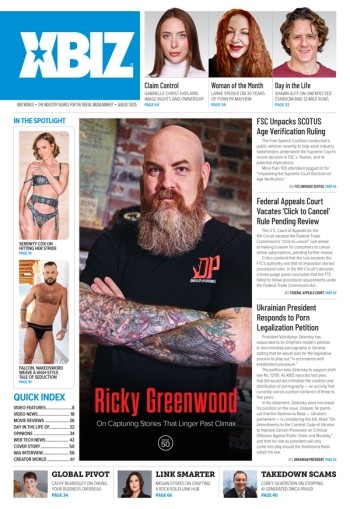"We don't see ourselves as a sex toy company and never have, from day one," says Theresa Sparks, president and CEO of Good Vibrations. "It was created as a vehicle for helping and educating women. That hasn't changed one bit."
Defined by an unwavering commitment to promoting sex positivity, the progressive cultural platform at the heart of Good Vibrations became, in many ways, the basis for a business model that ultimately spring-boarded efforts toward growth and expansion. But there were hiccups along the way.
Blank relinquished sole proprietorship in 1992 after losing interest in the business, and Good Vibrations became a worker-owned cooperative. Revenues from the storefronts and mail order side of the business financed unprofitable ventures like Down There Press, which published women's erotica, and unsuccessful forays into video and audio production.
Banks and venture capitalists were hesitant to fund such an unorthodox business setup, just as company insiders were wary of mainstream influences from the outside.
With each employee/ owner holding an equal vote in company decisions, attempts at new strategies or even common business practices were log-jammed in a democratic morass of ideological debate. It sometimes took months to argue the implications of something as basic as installing a new phone system, with only one vote needed to veto the whole idea.
"Ten years ago, Good Vibes was 90 percent culture and 10 percent business," Sparks says. "What we've tried to do, by increasing the business aptitude of the company, is expand and take the values beyond where they are now."
So, in the odd evolution of the business that really never saw itself as a business, Good Vibes restructured in 2006 from an employee-owned cooperative to a general business corporation, while remaining fiercely protective of its cultural identity.
"When we restructured, we actually embedded those values into the by-laws and articles of incorporation so they can't be changed," Sparks says.
Oddly enough, those keystone principles, nurtured by the anti-capitalist, experimental business model of the past, may be exactly what propel Good Vibrations to becoming an industry leader.
The changes at Good Vibrations played out over a long process. In 1999, Beth Doyle came aboard as general manager, hired from the outside in the hopes that her corporate experience would help move the company forward.
She immediately recognized the need to fill several executive positions with new hires who had corporate or retail backgrounds.
Doyle discovered Sparks in the mailroom. With 20 years of experience managing waste-disposal companies, Sparks was having difficulty finding employment after a sex-change operation, finally landing at Good Vibrations in 2001. When Doyle realized Sparks' expertise, she offered her a position as finance manager.
Then Jason Plotzker, former director of online sales for Restoration Hardware, came on in 2003 as merchandising manager. In 2004, Doyle recruited Nancy
Crowe, a seasoned retail consultant, as director of marketing. Crowe remembers the difficulty, at first, of trying to sway the old-timers into believing her presence would be good for the company.
"There was a fair amount of pushback on new ideas because it was different, and I think many people fear things that are not the same," explains Crowe. "Some of the new programs that were being designed were not for everybody's liking, and it took a little while to win them over."
Crowe introduced simple marketing tools, like a mailing list signup incentive program in the company's three stores. Other basic marketing functions came into play: A marketing research study determined Good Vibrations' largest buying demographic is 35- to 45-year-old straight women in couples who earn more than $50,000 annually — a statistic that surprised many at the company.
Working with Plotzker, the three Bay Area storefronts were updated with new merchandising displays and brightly colored advertising banners. Department store-style blue-and-orange shopping bags emblazoned with the Good Vibrations logo are part of a larger branding campaign that conveys a customer-friendly, comfortable attitude.
Innovative advertising placements such as billboards on the sides of San Francisco's Muni buses and marketing geared toward peak holiday periods raised consumer recognition.
Re-establishing relationships with the mainstream press, Crowe moved to position Dr. Carol Queen, Good Vibrations' in-house sex expert and board member, as "the thought leader of the industry — the go-to person for any comments regarding sexuality, relationships or romance."
Queen, who has been with Good Vibrations since Blank was owner, recalls impassioned discussions during the debate over whether to incorporate. "I just had to stand up again and again, and say, 'It's not going to change what Good Vibrations means to the community,' which is sex-positive, high-quality education and products.
"The co-op was a business model we all hoped would carry us forward. But it wasn't the only business model that could carry us forward."
Brave New Year
On Feb. 1, when the documents of incorporation were filed in Sacramento, two other significant events took place.
First, Good Vibrations signed an agreement with the Center for Sex and Culture, allowing Dr. Queen and the Center's staff the opportunity to create a web-based sex-positive curriculum that will eventually be offered to Good Vibrations' wholesale and retail customers. Certified continuing education classes also are being developed for sex therapists and other health professionals.
And in Brookline, Mass., Good Vibrations officially opened an East Coast flagship store, complete with the new branding and merchandising components in place. The company says the store has shown a profit since its first month of operation.
Plans are underway for a March 2007 remodel of the East Bay location in Berkeley, Calif.. The store concept has a sleek, postmodernist look with a modular design aimed at creating a non-threatening, mall-friendly environment. It will serve as the template for three new stores Sparks would like to see opened by the end of 2007.






